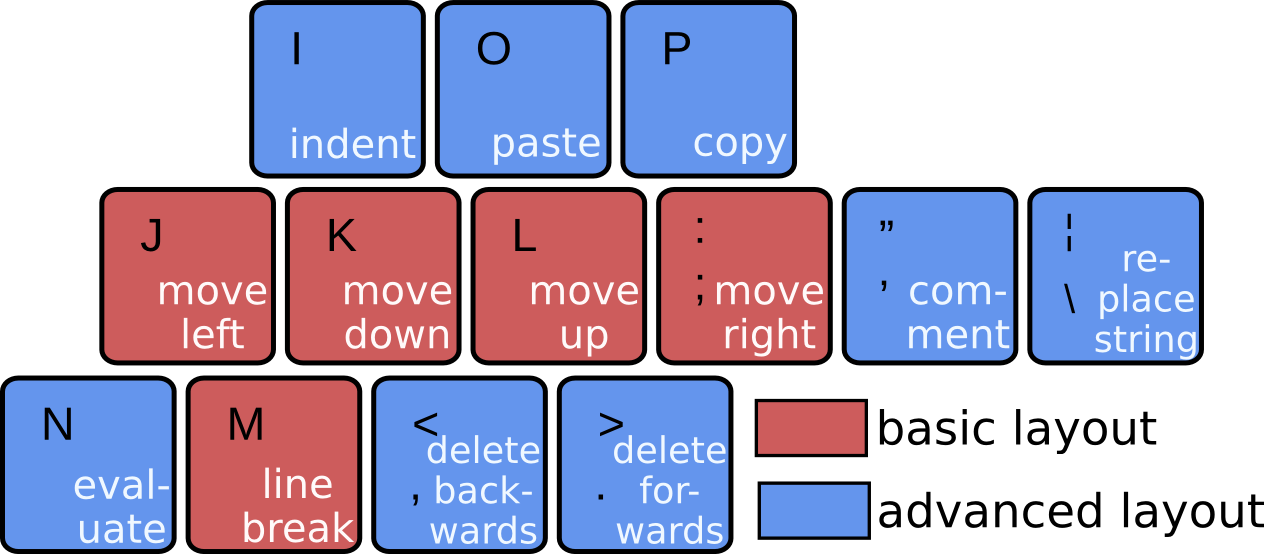
Let’s face it, the navigation in plain Emacs is not that sophisticated. Actually, it’s almost unusable. The approach of Evil-mode, on the other hand, is not a bad idea but I never really liked the way VI is doing things. Context switches are just not my style. I definitely prefer the key combination approach of Emacs.
So what can be done instead? Well, why not creating a mixture of both worlds?
This project started as a bunch of keybindings in a custom keymap in my .emacs configuration file some years ago. Over time this keymap was growing more and more in size and functionality and soon it became the major part of my .emacs. At some point is said to myself: Okay, why not just make a mode out of it? Maybe someone else could benefit from this piece of software too. And it’s not a bad idea to write packages for programming languages. How hard could it be? Boy, it can be hard 😄 .
After struggling a while to make the keymap of my minor mode not just working with the ones of all the other ones but also to lay on top of them, I decided to place it in a variable called overriding-local-map. This way it shadows all possible other keybindings and you can always navigate using the j k l ; keys. But on the other hand, keybindings assigned to specific words or regions of the buffer, e.g. jumping to the next mark while expanding a snippet using YASnippet, won’t work anymore. But this is a price I am happy to pay for a way faster and more convenient navigation. You disagree? Then leave a comment or a mail. I’m willing to adjust the package for others to benefit from it too.
Usage

In the lightning-keymap-mode a keymap tailored for fast navigation and editing is superimposed on top of your regular keymaps using a minor mode. Since this might shadow some essential key bindings you use on a regular basis, you can turn the mode on and off using F5.
There are two basic ideas to this package:
- Navigation happens using the j, k, l, and ; keys and there are a bunch of useful and frequently used commands placed on the surrounding keys, like killing (cutting), yanking (pasting), copying, line breaks etc.
- There are several different ‘layers’ invoked by the Ctrl,
Meta, and Shift keys and their combinations.
While the Ctrl key is invoking basic (slow) navigation, like
moving forward or backward one line or character, the Meta key
speeds things up by moving forward or backward a word or
paragraph. The combination of both features the most fast
behaviour (e.g. Ctrl + Meta + ; will move the point to the end of
a line and Ctrl + Meta + l to the beginning of the buffer).
A notable exception is Meta + Shift, which is used to navigate
between buffers.
The second idea is also applied on most of the additional key bindings: Ctrl + , deletes backwards a character, Meta + , deletes backwards a word, and Ctrl + Meta + , deletes the current line (apart from this, those commands are also sensitive towards marked regions).
The evaluation of code chunks bound to the n key are currently just supported for ESS and python-mode.
Installation
Make sure you have an Emacs 25.1 or newer installed.
In order to use the lightning-keymap-mode, you have to clone this repository to your local device
git clone git@github.com:theGreatWhiteShark/lightning-keymap-mode.gitand add the following lines to your .emacs file in your home folder.
(add-to-list 'load-path "~/PATH-YOU-CLONED-LIGHTNING-KEYMAP-MODE-TO")
(require 'lightning-keymap-mode)
(lightning-keymap-mode 1)Customization
By setting the lightning-basic-keymap variable to non-nil, the user can decide whether she wants to use just the basic navigation and line breaking instead of the full keybindings offered by the lightning-keymap-mode.
If the variable lightning-keymap-mode-modifies-string-replacement
is set to non-nil, not the internal string-replace function, but a
customized version lightning-keymap-mode-replace-string will be
used. Within this function the default option of the FROM argument
of the replacement function (what to replace) will be set according to
word at point (at the current position). Therefore, it loses the
ability to perform the last replacement as the default. You are free
to decide on your own which functionality you find more useful.
For additional information and customization please refer to the customization group Editing > Lightning or the comment section in the beginning of lightning-keymap-mode.el.
Notes
If you plan to use YASnippet in combination with lightning-keymap-mode, be sure to use a YASnippet version >= 0.12.0!